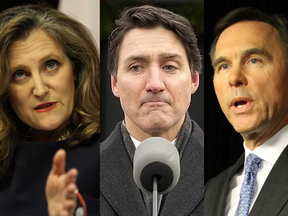Caps on newcomers could ease the housing crunch but fuel labour shortages and inflation, says economist
Article content
The federal government’s decision to bring in fewer newcomers in the next few years due to the housing crunch could create labour shortages and inflationary pressures on some areas of the economy if the right balance isn’t maintained, says an analysis by Canadian Imperial Bank of Commerce.
Canada’s record population growth in recent years eclipsed its available housing and the number of jobs the economy has created since 2019, but the increase didn’t have a uniform effect on the economy, the report said.
Advertisement 2
Article content
Article content
“We estimate that while the population has risen by roughly 1.1 million (approximately 35 per cent) more than housing availability could accommodate since 2019, the increase has eclipsed labour force needs by “only” between 200,000-700,000 (five-20 per cent),” the report said.
CIBC economist Andrew Grantham said this means population growth was “way above” what the country could handle from a housing point of view, but it was only “slightly ahead” of what’s needed in the labour force, he said.
“Given the fact that we have an aging domestic work force, that excess population growth is actually a lot less,” he added.
Grantham’s report said if authorities solely focus on adjusting the number of newcomers to match housing availability, it could lead to a shortage in the labour force.
“Everything that has been written on population growth … has really been only on housing,” he said. “But that’s just one part of the issue. We have labour force needs as well. Everyone needs to be aware of this balancing act, whether it be policymakers or the Bank of Canada.”
Prime Minister Justin Trudeau’s government has taken a number of steps in the past six months to slow down the intake of newcomers.
Article content
Advertisement 3
Article content
In March, the government said it will limit the number of temporary residents entering Canada to five per cent of the overall population over the next three years, compared to the existing 6.2 per cent, or 2.5 million students, foreign workers and asylum seekers.
In January, it imposed a two-year cap on new international students and restricted eligibility for work permits for post-graduates and their spouses, and in November, 2023, it decided against increasing the number of permanent residents it wants to bring in from 2026 onward.
The limitations on newcomers, whom Canada has traditionally relied on to boost its economy, were announced after the country posted record population growth of more than two million people in the past two years, primarily due to a rise in temporary residents.
As a result, some economists expect Canada’s population growth rate to decline by about two-thirds to around 400,000 annually in a couple of years, compared to last year’s growth of 1.25 million.
“With so much attention focused on the link between immigration, population growth and housing affordability, it is easy to lose sight of the positive impact that newcomers into the country are having, particularly in the labour market,” the CIBC report said.
Advertisement 4
Article content
Grantham said that as Canada’s domestic workforce ages, young newcomers have helped slow the decline in labour participation rates. Non-permanent residents and new immigrants have also played an important role in reducing elevated job vacancy levels as the economy was coming out of the pandemic.
“Without this boost to labour supply, wage pressures may have proved even more persistent than they already were,” the report said.
However, it added that the surge in the population eventually “may have been a case of too much, too soon,” and that as the demand for labour eased, newcomers were the “most negatively impacted.”
Canada’s unemployment rate rose above six per cent in March and was largely driven by a lack of jobs for non-landed immigrants and immigrants who moved to the country less than five years ago, the report said. The unemployment rates for these two groups are well above where they stood in 2019, while the rate of joblessness for the remaining population remains slightly below that mark.
Grantham said the “perfect case” would be for some of the government incentives around building the economy to take hold once interest rates start coming down, which would then allow policymakers to bring in the appropriate number of workers for the labour market. But he isn’t sure about the likelihood of that scenario.
Advertisement 5
Article content
“It’s a very difficult balancing act for the next two or three years,” he said.
Recommended from Editorial
-

The productivity ’emergency’ and the role newcomers play
-

Caps on newcomers may hurt businesses, economy
-

Canada caught in population trap, economists warn
Bank of Montreal economist Robert Kavcic said the changing rules for newcomers shouldn’t be viewed as a “pro-immigration versus anti-immigration question,” but about the right level of inflows.
“Clearly, 1.3 million per year is too much for the labour market to absorb,” he said. “From a long-term perspective, I think permanent resident targets in the 400,000 to 500,000 range are appropriate to offset future retirements, and are just about what we can adequately provide infrastructure for.”
• Email: nkarim@postmedia.com
Bookmark our website and support our journalism: Don’t miss the business news you need to know — add financialpost.com to your bookmarks and sign up for our newsletters here.
Article content
Immigration caps can help housing, but hurt labour: CIBC
2024-04-20 14:00:04






